Cholera cases on the rise in Somalia amid rising displacement of people
Suspected cholera cases surge in Somalia as conflict and a multi-season drought displace more than 1.4 million people, many into camps lacking access to safe water and sanitation
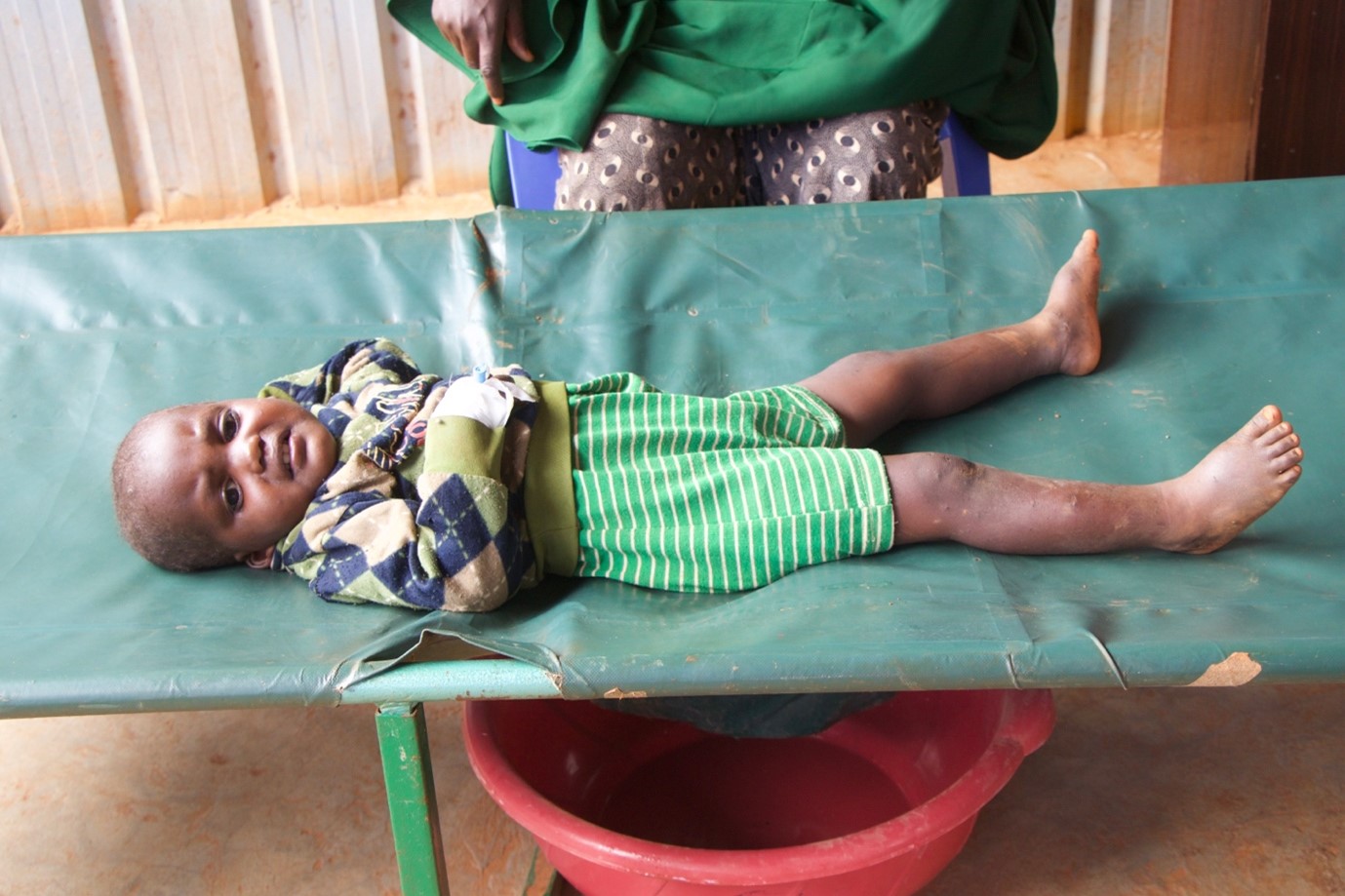 A 3-year-old Somow lies stretched out on a cholera cot at Bayhow General Hospital in Baidoa, Somalia, 21 March 2023. Credit: WHO/Somalia
A 3-year-old Somow lies stretched out on a cholera cot at Bayhow General Hospital in Baidoa, Somalia, 21 March 2023. Credit: WHO/Somalia
BAIDOA, 17 May 2023 – Stretched out on a cholera cot, 3-year-old Somow defaecates directly into a bucket through a hole in a thin mattress. Since drinking contaminated water, he has been wracked by vomiting and violent episodes of watery diarrhoea.
“He fell ill earlier, and then it came back, that’s when I decided to seek treatment,” his mother, Nuney Ibrahim Yusuf explains, brushing flies from the young boy’s face and legs, at a cholera treatment facility in Baidoa, in southwest Somalia.
Somow is among an increasing number of patients with suspected cholera across Somalia, where forced displacement, poor sanitation and climate shocks are creating the perfect conditions for large-scale outbreaks of the disease.
Nationally, about 8 million people lack access to safe water, sanitation and hygiene services in Somalia, where drought and insecurity displaced 1.4 million people in 2022.
Last year, WHO treated more than 130 000 cases of acute diarrhoeal disease – including 15 600 cases of suspected cholera in cholera treatment centres – the highest number in 5 years, although more cases likely went unreported in this Horn of Africa country owing to underreporting and other weakness in the disease surveillance system.
On his admission to the treatment centre at Bayhow General Hospital in Baidoa, doctors gave Somow oral and intravenous rehydration, and began treatment with antibiotics. He also received zinc supplements, which have been shown to reduce the severity and duration of diarrhoea in children suffering from cholera.
Displaced by insecurity and severe drought, the numbers of internally displaced people trekking to Baidoa reached 660 000 last year, nearly double the number in 2018. Most live in unsanitary conditions in dozens of informal settlements of fragile shelters built of sticks and covered with plastic and rags that ring the city.
“The latrines we have are full, there is nowhere to wash, and we have new people arriving,” says Abdulkadir Abdinur Adan, a community leader at the city’s Raama Cadey settlement, which is home to more than 1800 people. “Children have diarrhoea and there could be a cholera outbreak at any time. It is a great concern,” he adds.
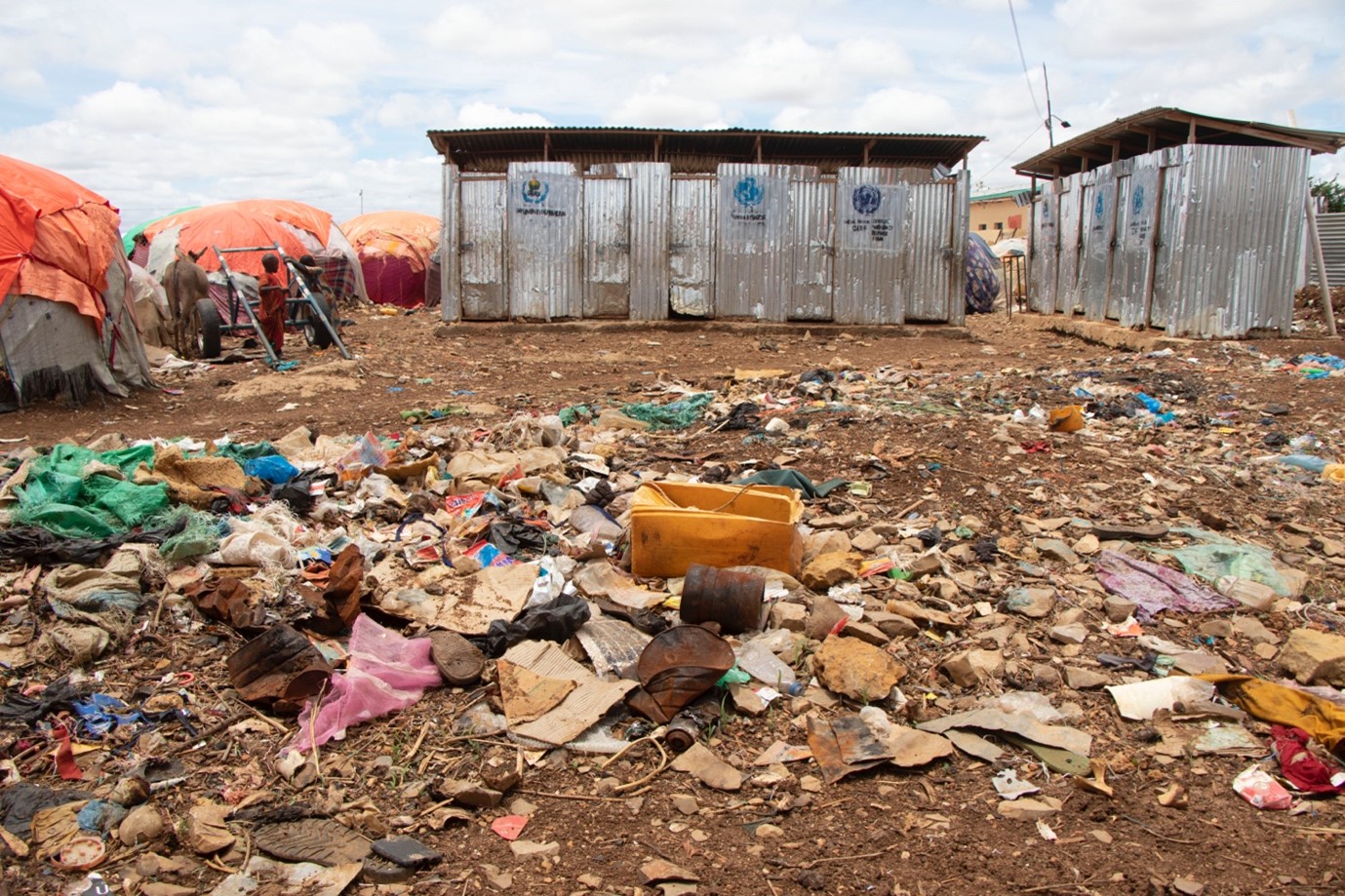 Shuttered latrines at Raama Cadey camp for internally displaced people in Baidoa, Somalia, 22 March 2023. Credit: WHO Somalia
Shuttered latrines at Raama Cadey camp for internally displaced people in Baidoa, Somalia, 22 March 2023. Credit: WHO Somalia
Like others across Somalia, the settlement comprises tightly packed, single-room shelters hastily erected on bare earth. It has just 10 latrines, all padlocked shut at the time of one recent visit. Open defecation is common, and many residents collect contaminated water from shallow wells, known as war, or hauled in on donkey carts in barrels.
Epidemiologists say waterborne disease transmission is being further exacerbated by a persistent multiyear drought. They cite a recently published retrospective mortality estimates titled “From insight to action: examining mortality in Somalia” according to which 43 000 excess deaths might have happened in 2022 alone. The drought devasted successive crops, killed off livestock and made residents dependent on dwindling sources of water.
“Boreholes dry up, water sources become more scarce, which means more people are concentrating to drink from a single source. If that source is contaminated, you get an outbreak,” says Joaquin Baruch, a WHO epidemiologist. “Cholera is highly contagious and has the risk of increasing and going through the roof very quickly. It can be very explosive if the suspected cases are not identified and treated early on when transmission is ongoing in a community.”
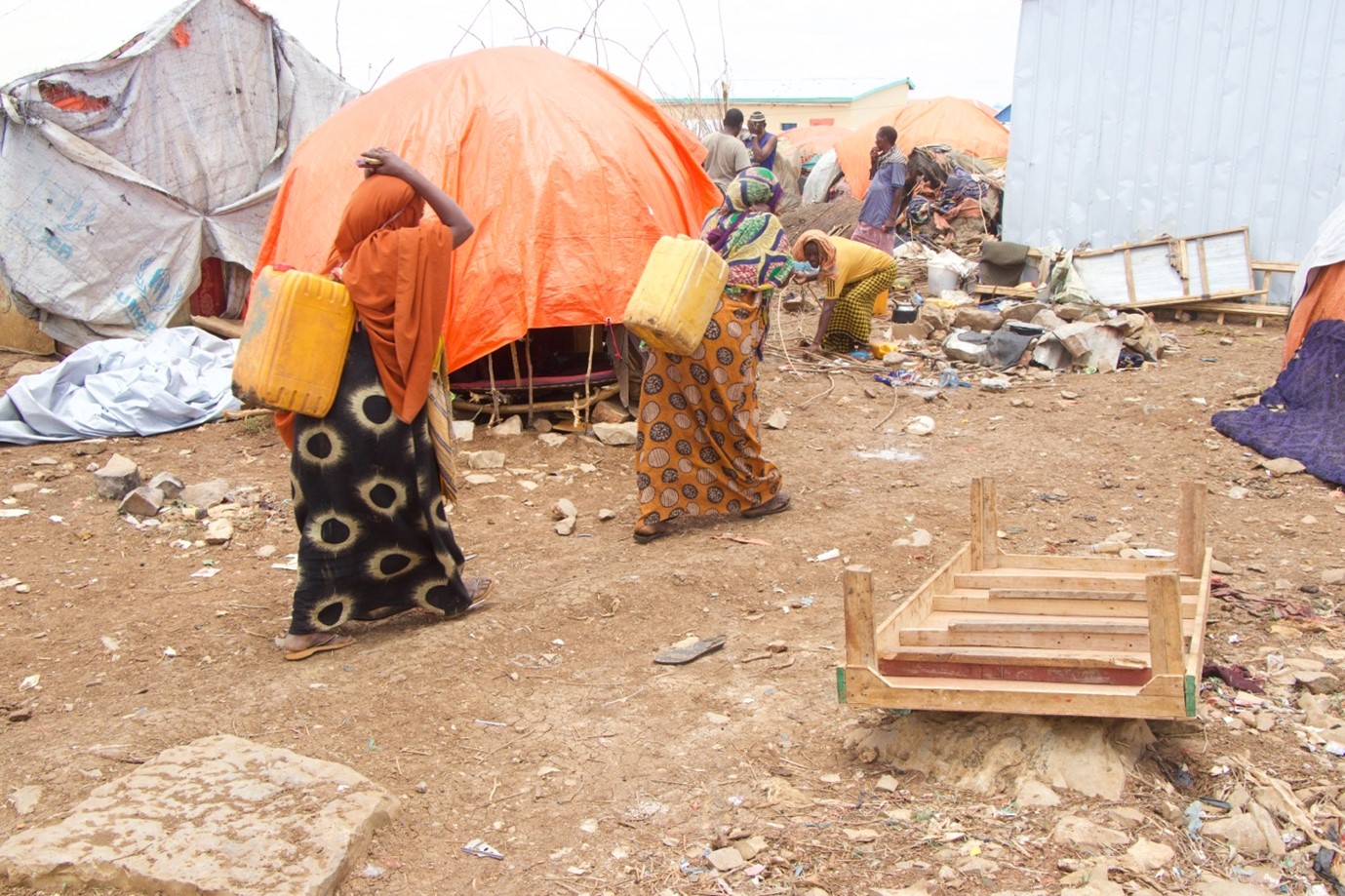 Women carry water at Raama Cadey camp for internally displaced people in Baidoa, Somalia, 22 March 2023. Credit: WHO Somalia
Women carry water at Raama Cadey camp for internally displaced people in Baidoa, Somalia, 22 March 2023. Credit: WHO Somalia
Cholera is an endemic disease in Somalia. Uninterrupted transmission is ongoing in certain parts of Somalia since 2017. This situation has exacerbated in recent time owing to severe drought in the country and currently, high-levels of transmission is ongoing in four districts in Somalia. As this year’s wet season gets under way with heavy rains and flashfloods in some areas, WHO is very concerned that cholera cases could rise sharply among the forcibly displaced owing to rapid community spread as cholera organisms thrive and survive in contaminated water.
“Displacement is driving people into camps where access to clean water and sanitation are extremely limited,” warned WHO Representative to Somalia, Dr Mamunur Rahman Malik. “Cholera is present, and there is a serious risk of an explosive outbreak that would prove difficult to contain if early actions and recommended public health measures such as availability of safe drinking water and safe sanitation services, improved hygiene and improved access to treatment are not ensured.”
In a race to prevent it, WHO is working closely with the Ministry of Health and Human Services to ensure that everyone suffering from acute watery diarrhoea has access to early treatment and care. WHO is also working to implement reactive vaccination campiagn using oral cholera vaccine (OCV) in the hotspots In addition, it is improving access to primary health care services and working with its partners such as UNCEF to improve availability of safe water and adequate sanitation for the high-risk populations.
But for many Somalis, displaced from their homes by conflict and drought, the issue remains a lack of access to potable safe water. In Baidoa, clean water is available at a cost of three US cents per litre, a sum out of the reach of most displaced people, like Nuney, who lost her livelihood when drought forced her to abandon her land.
“We don’t have any source of money to buy clean water, so we use the well,” says Nuney, who is concerned for Somow once he is discharged. “I am worried that if he drinks that water, he will fall sick again,” she adds.
On the other side of the cholera treatment ward is Hasale Khalif Jibi, standing vigil beside her 18-month-old son, Abdi Hasanow. The youngster was admitted the previous evening with violent diarrhoea and vomiting after drinking water from a communal well at a displacement camp. He too is on the mend after treatment, although Hasale remains concerned for his chances of staying healthy once discharged. “Nothing has changed,” she says, with resignation. “The water is there, and we will drink it.”
 Hasale Khalif Jibi sits with her 18-month-old son Abdi Hasanow at a cholera treatment centre at Bayhow General Hospital in Baidoa, Somalia, 21 March 2023. Credit: WHO Somalia.
Hasale Khalif Jibi sits with her 18-month-old son Abdi Hasanow at a cholera treatment centre at Bayhow General Hospital in Baidoa, Somalia, 21 March 2023. Credit: WHO Somalia.
For additional information, please contact:
Kyle DeFreitas, External Relations Officer,
Fouzia Bano, Communications Officer,
Related links
Please see the links below for additional information:
Acute watery diarrhoea/cholera situation report, Week 16, 17-23 April 2023
/images/stories/somalia/documents/technical-programme-update-september-december-2022.pdf?ua=1
WHO launches training to transform the care of mothers and newborns in Somalia
Mogadishu 5 May 2023 – The World Health Organization (WHO) Country Office in Somalia and the Federal Ministry of Health have come together on the International Day of the Midwife to recognize the essential role of midwives in delivering quality health care services and reducing preventable maternal and neonatal morbidity and mortality.
Befitting to this year's International Day of Midwife theme of "Together Again: From Evidence to Reality”, WHO Is supporting the Ministry of Health to launch a standardized national basic emergency obstetric and newborn care (BEmONC) training programme across the country. Somalia is considered one of the most dangerous places to give birth, where every 25th mother dies while giving birth, compared to one in 49 in comparable low-income countries, and according to the 2023 report on trends in maternal mortality 2000 to 2020, Somalia had a maternal mortality ratio of 621 per 100 000 live births in 2020. The high maternal mortality ratio is attributed to health system failures resulting in delays in seeking and receiving care, poor quality of care, shortages of essential medical supplies, and poor accountability of health systems.
"Enhancing the skills and knowledge of health workers, especially midwives and nurses, using manual is critical for saving lives and improving the health and well-being of mothers and children in Somalia”, commented Dr Al-Umra Umar, Programme Lead for Reproductive, Maternal, Neonatal, Child and Adolescent Health at the WHO Somalia Country Office, while highlighting the importance of the skilled health workforce.
 Early identification of risk factors for pregnancy and delivery complications can prevent maternal and newborn deaths. Credit: WHO/Somalia
Early identification of risk factors for pregnancy and delivery complications can prevent maternal and newborn deaths. Credit: WHO/Somalia
A standardized BEmONC training package is being developed to train midwives and nursing staff at health facilities to manage major causes of maternal and newborn mortality, such as haemorrhage, infection, pre-eclampsia/eclampsia, obstructed labour, and newborn asphyxia. The training package will also help improve the readiness of health facilities to deliver good quality obstetric and newborn care.
Dr Naima Abdulkadir, Maternal and Reproductive Health Manager from the Federal Ministry of Health, while thanking WHO for their continued support, said, “The roll-out of standardized BEmONC training nationally will benefit mothers and newborns and is a significant step towards providing harmonized high-quality maternal and newborn health services in Somalia”.
For additional information, please contact:
Kyle DeFreitas
External Relations Officer
Fouzia Bano
Communications Officer
Note to editors
Globally, about 45% of maternal and 36% of neonatal deaths occur during the first 24 hours after birth. These deaths are mainly preventable if BEmoNC services are available at all health facilities. However, the 2016 SARA (service availability and readiness assessment) survey conducted in Somalia illustrated that in 2016 BEmONC services were only available in 45% of urban health facilities and 20% of rural health facilities. Only 32% of births had skilled health care provider support, and 21% were delivered at a health facility. Currently, WHO is conducting another survey using the Harmonized Health Facility Assessment (HHFA) tool to better understand the coverage of BEmONC services and identify service gaps in emergency obstetric and newborn care. To respond to these challenges, WHO Somalia supports the Federal Ministry of Health in improving the country's reproductive, maternal, neonatal, child, and adolescent health services through various means such as policy, norms and standards settings, guideline development, leadership training, capacity-building of health care workers, and implementation of evidence-based interventions. Although progress has been made, the country remains off-track for most of the health-related Sustainable Development Goals (SDG3), particularly targets 3.1, 3.2, 3.7 and 3.8.
Related links
WHO pilots first-ever programme leadership and management training for RMNCAH in Somalia
World Malaria Day 2023 – zeroing in on malaria
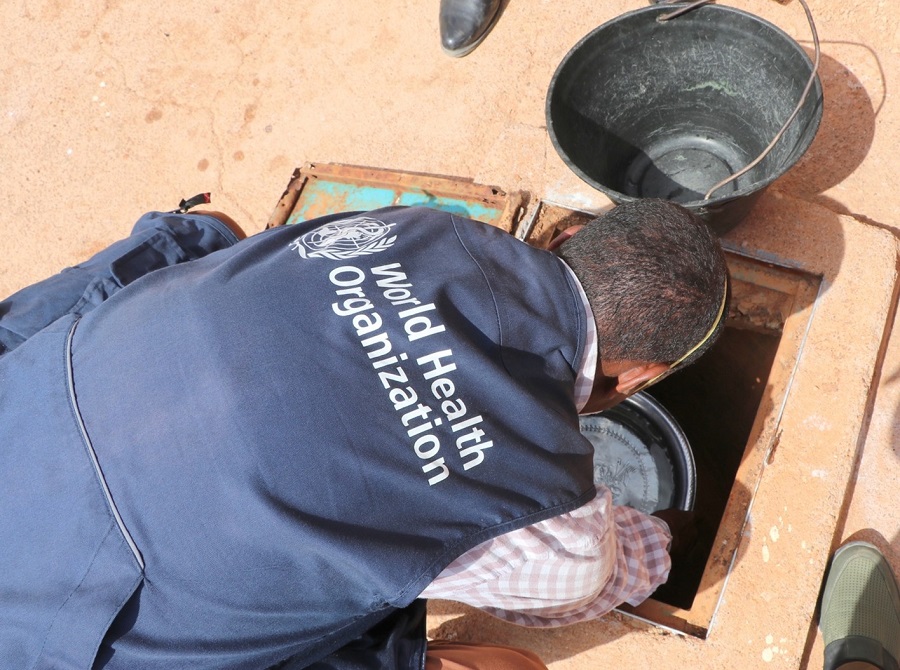 A WHO staff member inspecting a small water tank to identify and control mosquito breeding sites. Credit: WHO
A WHO staff member inspecting a small water tank to identify and control mosquito breeding sites. Credit: WHO
Mogadishu 25 April 2023 – The Federal Ministry of Health, together with the World Health Organization (WHO) Somalia, commemorates World Malaria Day on 25 April to reflect on the progress made in the fight to eliminate malaria. Malaria continues to pose a significant threat to the health and well-being of millions of people globally, particularly in sub-Saharan Africa, where most malaria cases and deaths occur. On this year's World Malaria Day, WHO emphasizes the importance of implementing strategies and reaching marginalized populations in the fight against malaria. As part of this year’s theme "Time to deliver zero malaria: invest, innovate, implement" campaign, WHO highlights the critical need to provide access to diagnostics, treatment and care for those who need them most.
Significant progress has been made in malaria control in Somalia, with substantial decreases in transmission since 2019, thanks to scaled up interventions. Additionally, the impact of the drought in Somalia has contributed to reducing malaria transmission across the country, including in previously high and moderate transmission areas along the Shabelle and Jubba Rivers. Despite a high risk of epidemics in northern regions, malaria infections in the community remain low and much of the country is suitable for elimination efforts.
Throughout Somalia, the malaria species Plasmodium falciparum has been the predominant cause of infection, accounting for over 92% of cases. This poses a complex situation due to the severity of malignant malaria. Furthermore, the invasive mosquito species Anopheles stephensi, capable of transmitting both P. falciparum and P. vivax malaria parasites, was detected in 6 locations in Somalia between 2020 and 2021. Unlike other major mosquito vectors of malaria, Anopheles stephensi thrives in urban environments, making vector control a top priority for the malaria programme.
On the road to zero malaria
The WHO Country Office, in collaboration with other stakeholders, mainly UNICEF, with support from the Global Fund to Fight AIDS, Tuberculosis and Malaria, provides support to the health authorities in efforts to tackle malaria transmission in the country. These include indoor residual spraying (IRS), distribution of long-lasting insecticidal nets (LLINs), larval source management, and malaria case management. WHO also supports the Government in strengthening surveillance and entomological monitoring efforts in the country, as well as monitoring insecticide susceptibility and drug efficacy on malaria parasites.
Dr Jamal Ghilan Amran, the Malaria Focal Point for WHO Somalia, emphasised the significance of adopting an integrated approach to prevent malaria. He stated, "Malaria prevention and surveillance are crucial elements of malaria elimination, mainly in the northern and central regions. Without efficient and coordinated prevention measures, coupled with robust surveillance, monitoring, and timely response to transmission pattern changes, we risk forfeiting the progress we have made in combating malaria."
In Somalia, malaria is endemic across the country, particularly in the south and central parts of the country. However, the country has decided that conditions were right to target 6 districts for elimination as a pilot project – Odweyne in the region of Togdher; Ainabo in Sool; Burao in Togdher; Sheikh in Sahil; Burtinle in Nugal; and Goldogob in Mudug – all in Somaliland and Puntland. Planning for other regions would have been a challenge, mainly due to insecurity. As a result, from May 2021 onwards, led by the Somali Government and supported by the Global Fund, WHO and UNICEF are rolling out national malaria elimination programmes in these 6 districts towards reaching the zero malaria target.
In 2022, 336 840 suspected malaria cases were tested, of which 11 550 were positive. Compared with 2021 and 2020, the positive cases declined by 11% and 61%, respectively. A total of 2 malaria-related deaths were also reported in 2022. All these cases were treated with artemisinin-based combination therapy as per the national treatment guidelines.
Similarly, in 2021 and 2022, WHO provided technical support to implement IRS interventions in Mogadishu, Qardo, and parts of Puntland and Somaliland. The intervention exceeded the initial target, with 85 837 households sprayed. Between June 2022 and March 2023, the LLINs mass campaign, supported by UNICEF, distributed almost 2.9 million bednets in 31 selected districts, including over 1.4 million LLINs distributed to internally displaced persons. Prior to the campaign, there was an extensive engagement between sub-recipients, the national malaria control programme, WHO, and UNICEF. This involved quantification and detailed microplanning. Additionally, the national LLIN distribution guidelines were updated to provide essential guidance to the government and distribution partners.
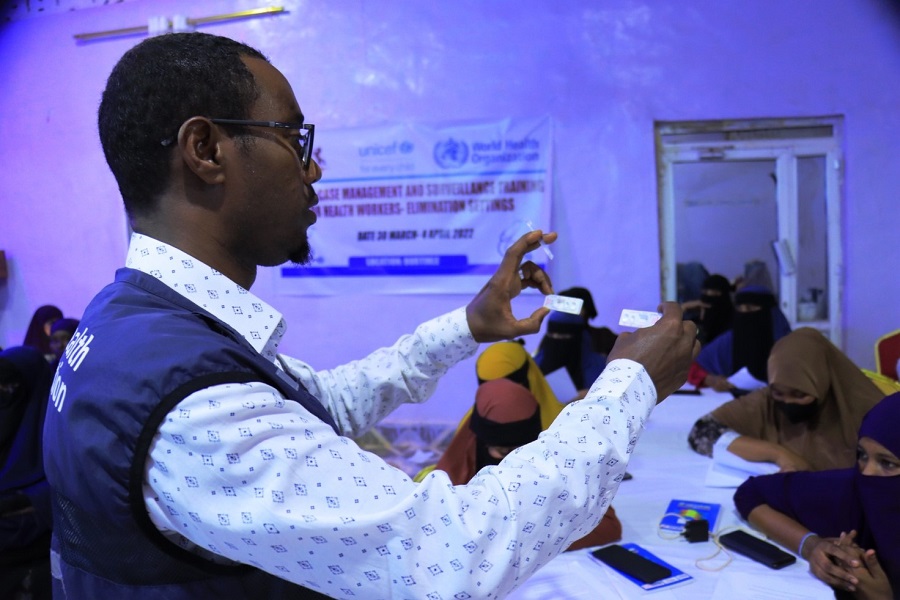 WHO conducts malaria case management and surveillance training for health workers 30 March–4 April 2022, Burtinle, Puntland. Credit: WHO
WHO conducts malaria case management and surveillance training for health workers 30 March–4 April 2022, Burtinle, Puntland. Credit: WHO
Further, entomological monitoring and surveillance have been enhanced through the reinforcement of sentinel sites and improved insecticide resistance monitoring, which aligns with the 2019 insecticide resistance monitoring plan that is currently being updated. Vector control has been incorporated into primary health care, and there is an emphasis on the collection of comprehensive entomological surveillance data. These data are used to identify malaria vectors, including Anopheles stephensi, and to monitor the spread, geographical and temporal distribution, and density of these mosquitoes, as well as their feeding and resting behaviours.
Although Somalia has made significant progress in controlling and eliminating malaria, much work remains to be done. This includes raising awareness about malaria prevention, community and private sector involvement, enhancing cross-border collaboration to prevent the importation of vectors and parasites, and ultimately achieving the goal of zero malaria-related deaths.
Global burden of malaria
According to the latest World Malaria Report 2022, from 2000 to 2015, the number of malaria cases decreased steadily; however, since 2016, malaria cases have been increasing. The most considerable increase was observed during the first year of the COVID-19 pandemic, between 2019 and 2020, with a rise of 13 million cases. In 2021, an estimated 247 million malaria cases and 619 000 deaths were reported. The WHO African Region bears the brunt of this burden, with 95% of malaria cases and 96% of deaths occurring in the Region. Children under 5 years old account for 80% of all malaria deaths in the Region.
The WHO Global Technical Strategy for Malaria 2016–2030 aims to reduce malaria incidence and mortality rates by at least 90% by 2030, eliminate malaria in at least 35 countries, and prevent a resurgence of malaria in all malaria-free countries.
------------------
For additional information, please contact:
Kyle DeFreitas
External Relations Officer
Fouzia Bano
Communications Officer
Related links
/somalia/news/at-risk-zero-dose-children-get-vaccines-as-somalia-drought-woes-mount.html
https://www.who.int/teams/global-malaria-programme/reports/world-malaria-report-2022
World Immunization Week 2023: Somalia resolves to work on “The Big Catch-Up”
 Vaccinators continue to save children from vaccine preventable diseases across Somalia. Credit: WHO/Somalia
Vaccinators continue to save children from vaccine preventable diseases across Somalia. Credit: WHO/Somalia
Mogadishu, 24 April 2023 – The Federal Ministry of Health, in collaboration with the World Health Organization (WHO) and the United Nations Children’s Fund (UNICEF), observed World Immunization Week under the global theme of “The Big Catch-Up” with a resolve to strengthen primary health care and routine immunization across the country and ensure that no one is left behind.
World Immunization Week 2023 is being observed during the global COVID-19 pandemic and hence it has been given the theme of ‘The Big Catch-Up’. World Immunization Week was initially endorsed in May 2012 by the World Health Assembly (WHO's decision-making body) and the first World Immunization Week was observed the same year across 180 Member States of WHO.
The Federal Minister for Health Dr Ali Haji, on this occasion expressed gratitude to WHO and UNICEF for coordinating and collaborating with multiple partners and helping his government to catch up on lost progress in essential immunization, as a result of the global pandemic. Acknowledging the worst ever drought gripping the country, resulting in huge population displacement and outbreaks of diseases, Dr Haji hoped that “in line with the theme of the year -“The Big Catch-Up”, WHO and UNICEF would continue to support the Ministry of Health in building a strong immunization delivery system, sustain the progress made over the past few years in preventing a backslide of childhood immunization in the country and more importantly accelerate the campaign of “The Big Catch Up” to get back on track to ensure more people, particularly children, are vaccinated and protected from preventable diseases”.
As per UNICEF and WHO estimates, routi:ne immunization coverage in Somalia is low compared to other countries, and has been further impacted by the COVID-19 pandemic. The Ministry of Health, in collaboration with WHO and UNICEF, has made progress during 2022 to bridge these significant gaps in immunization by scaling up its efforts to strengthen routine immunization across the country.
WHO Representative to Somalia Dr Mamunur Rahman Malik while referring to the setbacks caused by global pandemic to routine immunization in Somalia, said that “Thousands of children under 5 have missed routine immunization during the past 3 years. The pandemic has disrupted essential immunization services in the country. We may anticipate a backslide of over 20% in routine immunization coverage unless we are able to rapidly catch up on lost progress.” He further said that, “WHO in collaboration with the Ministry of Health and UNICEF, is planning for a “Big Catch-Up” by developing an immunization recovery plan to catch up on all those children who have missed out on their routine immunization in the past 3 years, including all women of childbearing age and adults. This is our chance to restore immunization coverage to pre-pandemic levels and by working together with our partners, we can do it.”
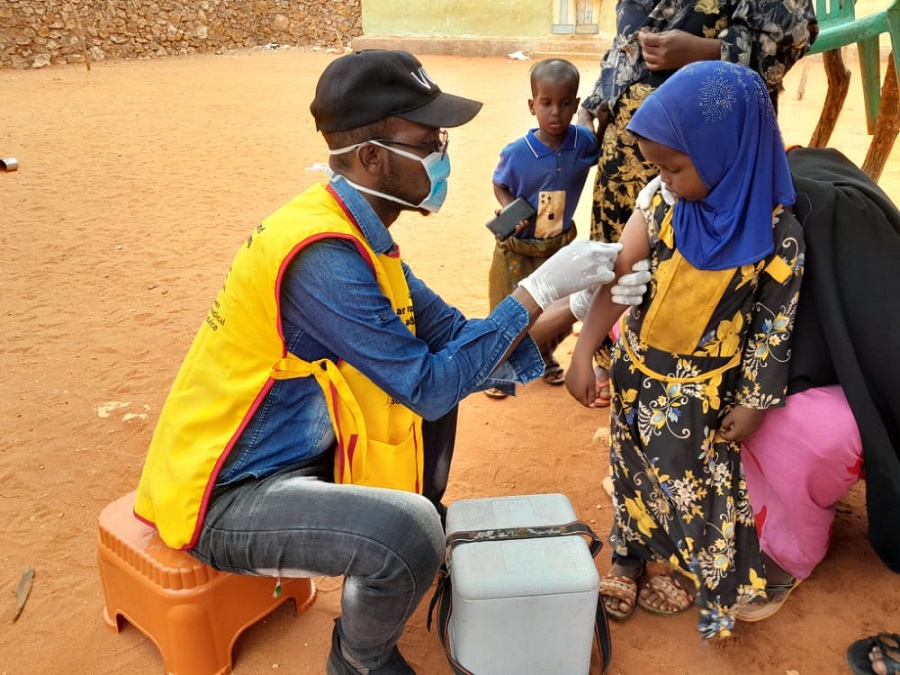 Locally recruited vaccinators are trusted members of communities across Somalia. Credit: WHO/Somalia
Locally recruited vaccinators are trusted members of communities across Somalia. Credit: WHO/Somalia
The Federal Ministry of Health, WHO and UNICEF during 2022 have jointly implemented 4 rounds of accelerated immunization activities, 5 polio campaigns, 8 campaigns for COVID-19, and nationwide integrated measles, tOPV, vitamin A and deworming campaigns. Additionally, WHO deployed more than 2100 community health workers while UNICEF has deployed over 6000 social mobilizers across the country to disseminate health messages to over 4.5 million people, as well as track and help immunize children who missed out on immunization. The community health workers have been working to find, register and refer the missed-out children and pregnant women to nearby health facilities and outreach sessions.
“UNICEF supports health systems for increasing routine immunization and integrated health and nutrition services to the children in Somalia, especially where coverage is low in hard-to-reach areas,” said UNICEF Deputy Representative, Nejmudin Kedir Bilal. “We are committed to continuing to support the Ministry of Health to generate more demand and acceptance of vaccines by the communities; to strengthen supply chain management system for vaccines and supplies; and to revamp management information system to track zero-dose children.”
The joint efforts made by the Ministry, WHO and UNICEF during the last integrated campaign helped to vaccinate more than 3.2 million children under 5 against measles and 3.5 million against polio. During 2022, immunization programmes also identified and vaccinated over 84 500 zero-dose children and vaccinated around 30 000 women of childbearing age with tetanus-diphtheria toxoids (Td2) by deploying integrated outreach teams. Somalia also managed to achieve the milestone of fully vaccinating over 41.7% of the adult population against COVID-19 in 2022.
Note to editors
Since the start of the COVID-19 pandemic in 2020, a widespread decline in childhood vaccinations has occurred globally, putting millions of additional children at risk for vaccine-preventable diseases. The continued decline in vaccination coverage since then was likely a result of many factors, including strained health systems caused by the COVID-19 pandemic, coupled with the primary focus being on the delivery of COVID-19 vaccines. These stresses have led to challenges with supply chains, human resources, and financing. Increasing vaccine misinformation, disinformation and hesitancy also likely contributed to declines in some countries. The risk of vaccine-preventable disease outbreaks is likely to persist if urgent action is not taken to recover immunization programme losses, especially in countries like Somalia, where the health sector is under immense stress of dealing with multiple outbreaks of measles, cholera and circulating vaccine-derived poliovirus 2.
-------------------------
For additional information, please contact:
Federal Republic of Somalia Ministry of Health and Human Services
UNICEF
Lisa Hill
Communications Specialist
WHO
Fouzia Bano
Communications Officer
------------------------
Related links
Expanded Programme on Immunization
State of the World’s Children 2023: For Every Child, Vaccination


